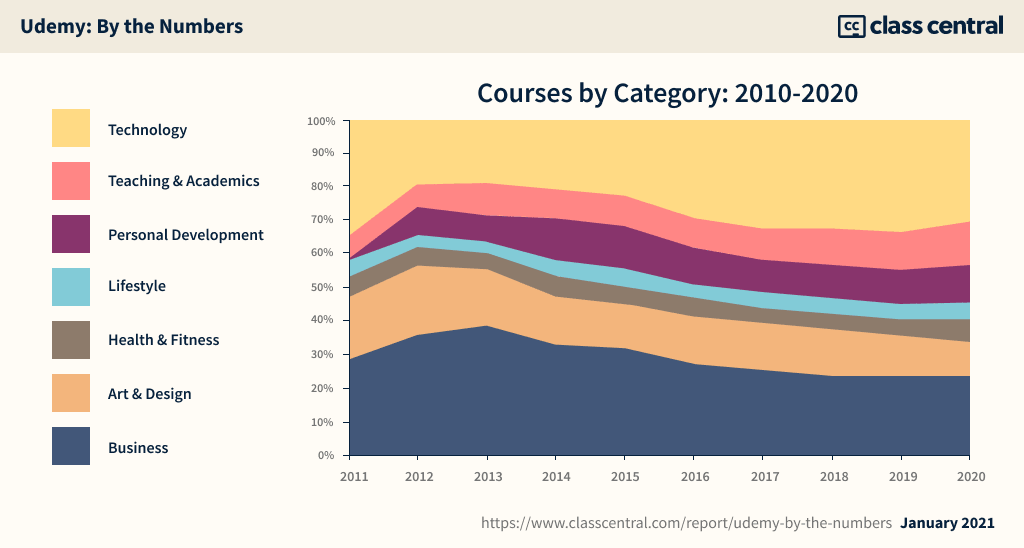Udemy to Test a Catalog Subscription for Consumers
After introducing a business subscription, Udemy announces they’ll soon pilot a consumer subscription.
A couple of weeks ago, Udemy announced they would change the way they share revenue with instructors. In this announcement, they also mentioned that in April, they will “begin piloting a version of the Udemy for Business subscription for individual consumers in the English market”.
This move might have been motivated by Coursera’s S-1 IPO filing. In my analysis, I noted that Coursera’s catalog subscription, Coursera Plus, had 50K subscribers. This might have prompted Udemy to pick up pace. Udemy is also expected to go public this year.

Early this year, Class Central wrote about Udemy Pro. Udemy Pro costs $19.99 and only encompasses a small curated collection of 24 courses related to obtaining different IT certifications.
But Udemy’s upcoming catalog subscription is based on Udemy for Business, which costs $360 per user per year, and grants access to around 5,500 courses, a small subset of the provider’s catalog. You can find a complete analysis of Udemy’s catalog here. In October 2020, Udemy announced that their enterprise business generated $100 million in annual recurring revenue.
This is similar to how Coursera Plus evolved out of Coursera for Business. Here’s a brief overview of this evolution exclusively captured by Class Central:
- Mid to Late 2017: Coursera runs a lengthy test where learners pay $49 per month to access to a majority of the catalog. Eventually, the idea is shelved.
- Dec 2019: Coursera makes a second attempt at a catalog subscription. They call it Coursera Plus. This time, it’s a yearly subscription instead of a monthly one.
- Feb 2020: Coursera Plus officially launches at $399 per year.
- Oct 2020: Coursera tests out a monthly pricing of $59 for Coursera Plus.
Coursera didn’t say how many of their 50K Coursera Plus subscribers were paying monthly vs annually.
| Revenues | Coursera | Udemy |
| Consumer |
$193M | $300M |
| Enterprise | $70.8M | $100M |
| Degrees | $29.9M | NA |
Another interesting tidbit of Coursera’s S-1 is the “Gross Margin”. Since Coursera relies on its partners to create courses, it also shares a percentage of the sales with them. The part of the revenue it keeps is called “Gross Profit” for that particular segment. And the “Gross Margin” is the “Gross Profit” as a percentage of the segments’ revenue.
| 2017 | 2018 | 2019 | 2020 | |
| Consumer Gross Profit | $43.7M | $57.6M | $64.6M | $106.5M |
| Consumer Gross Margin | 50% | 54% | 53% | 55% |
| Enterprise Gross Profit | $4.7M | $19.0M | $34.2M | $49M |
| Enterprise Gross Margin | 64% | 71% | 71% | 69% |
| Degrees Gross Profit | $2.5M | $7.4M | $15.1M | $29.9M |
| Degrees Gross Margin | 100% | 100% | 100% | 100% |
For Coursera, the Consumer Gross Margin is 55% while the Enterprise Gross Margin is 69%. This means that with catalog subscriptions, Coursera gets to keep a bigger share of the revenue than when it sells individual courses and specializations to consumers.
Udemy’s recent announcement also changed the share of the revenue the company keeps:
“Starting May 3, we’ll introduce a ‘blended’ share of 37% for sales not driven by instructor promotions, and keep the existing 97% rate for instructor-driven sales. This will replace the 25% and 50% rates previously assigned to paid and “organic” channels, respectively.”
If the dynamics of Udemy’s catalog subscription are similar to those of Coursera’s, this move might help Udemy’s IPO prospects as well as the long-term health of the company.
Tags







